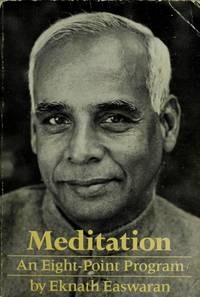 First edition | |
| Author | Eknath Easwaran |
|---|---|
| Language | English (orig.) & trans.: Bulgarian, [1] Chinese, [2] Czech, [3] Dutch, [4] French, [5] German, [6] [7] [8] Hungarian, [9] Korean, [10] Lithuanian, [11] Portuguese, [12] Romanian, [13] Russian, [14] Slovenian, [15] Spanish, [16] [17] Telugu [18] |
| Publisher | Nilgiri Press; others |
Publication date | 1978 (original); 2016; others |
| Pages | 237 (1978); 270 (2016) |
| ISBN | 978-1-58638-116-5 |
| OCLC | 950007677. |
Passage Meditation is a book by Eknath Easwaran, originally published in 1978 with the title Meditation. The book describes a meditation program, also now commonly referred to as Passage Meditation. Easwaran developed this method of meditation in the 1960s, and first taught it systematically at the University of California, Berkeley. [19] [20]
Contents
- Topics covered
- Method
- Questions and Answers
- Influence, research, use
- Editions
- See also
- References
- External links
The program is an eight-point program intended for the "spiritual growth" of the practitioner. The first step in the program involves meditating on a text passage, and since the 1990s the method as a whole has come to be known as "Passage Meditation" (not Easwaran's term). The book has been frequently reprinted and translated into 14 languages. It is reported that more than 200,000 copies were sold in the period of 1978 to 2001.
The first edition of the book had the full title Meditation; commonsense directions for an uncommon life (1978). A second edition in 1991 was subtitled a simple eight-point program for translating spiritual ideals into daily life, and a third, revised edition of the book was published posthumously as Passage Meditation; Bringing the Deep Wisdom of the Heart Into Daily Life (2008).
A fourth, revised edition was published as Passage Meditation – A Complete Spiritual Practice: Train Your Mind and Find a Life that Fulfills (2016). The fourth edition included a new part, not contained in earlier editions, with approximately 80 pages of "Questions and Answers" to numerous questions about meditation (pp. 182–264).